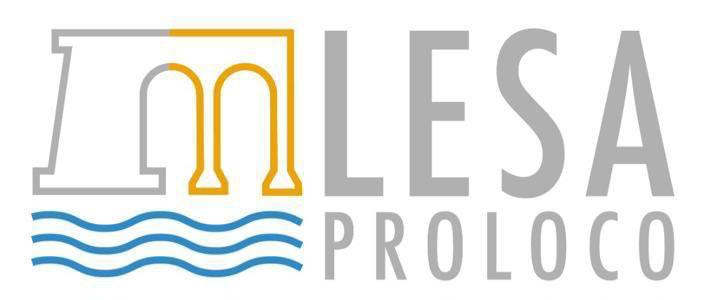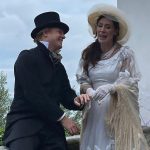1. Totem 11 – “Sentire e Sentieri” – Manzoni a Lesa
Villa Lesa, il borgo.
ITALIANO
Clicca sul simbolo ▶️ qui sopra per sentire l’audio.
ENGLISH
Click on the ideogram ▶️ above and listen.
“Sentire e Sentieri”
– Manzoni a Lesa –
Scarica qui la Mappa, Map
Leggi in ITALIANO
Siamo accanto al parco giochi di Villa Lesa, una delle 4 frazioni del comune di Lesa, le altre sono Solcio di Lesa, Comnago e Calogna. Tra i Villesi , soprannominati “ cagaret” ed i Lesiani, detti “persigat” regnava da sempre una forte rivalità, che si pensa possa derivare dal periodo di Cristianizzazione in quanto i Villesi rimasero legati più a lungo ai riti pagani. Dispute, risse e scherzi erano all’ordine del giorno. Si racconta che in occasione del posizionamento della Statua bronzea in onore dei Caduti della Grande Guerra che troverete sulla strada che conduce alla Stazione Ferroviaria, i Villesi di allora abbiano scelto di posizionarla con le “terga “ rivolte verso Lesa in segno di disprezzo. Attualmente la situazione è tranquilla e le rivalità un ricordo!
Almeno per ora…
Dall’altra parte della strada, davanti ai giochi per i bambini, potete intravvedere il bellissimo parco del palazzo settecentesco Conelli De Prosperi, demolito negli anni 1980 per costruire l’attuale Residence. Il parco è oggi privato e non visitabile.
A sinistra il cimitero con in centro la grande Cappella appartenente appunto ai Conelli de Prosperi, potente famiglia dove Francesco fu dal 1852 e per ben 25 anni senatore del regno Sabaudo.
Nel cimitero, in marmo bianco, anche la tomba di Giulio Carcano, della moglie Giulia e della figlia. Si racconta poi che, nel cimitero di Lesa, sia stata sepolta per un certo periodo la contessa Teresa Borri Stampa, seconda moglie del Manzoni. Oggi, dopo diversi spostamenti, se ne sono perse le tracce ed è diventato quasi un mistero.
Ma tornando a noi, avete per caso voglia di fare un po’ di sport?
Qui a Villa Lesa, se volete fare una partita a pallone, basket o siete degli skater, dietro alle scuole potete trovare il nuovo parco dedicato ai ragazzi che, per l’appunto, ospita anche un moderno skate park. La scuola media è intitolata ad Alessandro Manzoni.
Allontanandosi dal lago e salendo verso monte, verso le frazioni di Calogna e Comnago, c’è poi la chiesa Parrocchiale di Villa Lesa che ha la caratteristica di presentare 2 diverse chiese confinanti.
Quella più piccola che si presenta sulla sinistra è la prima chiesa di Villa dedicata a San Giorgio che si suppone sia stata edificata sopra un preesistente edificio di culto pagano ed era parrocchia già nel 1300. Del campanile in stile romanico si hanno notizie già dall’anno 1000, fu costruito come torre campanaria e di avvistamento e mantenuto. Sulla parete di fondo di questa chiesa esiste un dipinto murale raffigurante la crocifissione di Cristo attribuito alla scuola di Gaudenzio Ferrari.
La basilica più grande che si presenta sulla destra è stata eretta e dedicata a San Giovanni Battista nel 1774.
Tornando a tempi più recenti, dovete sapere che Villa Lesa aveva ben due Trattorie rimaste nella storia: la “Trattoria del Fico” vicino alla chiesa e quella del “Pesco Reale” sulla strada che sale verso Comnago, primo esercizio pubblico a Villa Lesa ad installare il televisore. Erano fino alla fine del secolo scorso un importante riferimento per gli abitanti e per i villeggianti. Inevitabile goliardico punto di ritrovo per personaggi locali e non solo, come per esempio il “Pinza”, proprietario della storica osteria “Briosca” dei Navigli a Milano dove si può affermare sia nato il moderno cabaret in Italia. Se lo volete sapere, il “Pinza” era così soprannominato perché apriva le bottiglie di birra a mani nude.
Risalendo la strada che qui davanti a voi passa sotto il ponte della ferrovia e conduce all’Antico Maniero, si arriva al Lavatoio di Villa Lesa recentemente ristrutturato e dove le donne tra una chiacchiera e l’altra, facevano il bucato.
La strada del lavatoio vi condurrà, se lo vorrete, al Punto Panoramico di Via dei Varim e poi a Belgirate per la strada alta.
Non dimenticate di scaricare la Mappa “Sentire e Sentieri “- Manzoni a Lesa dal Totem davanti a voi e Cercate il corrispondente segnaposto viola.
Coraggio! la salita non è molta, il percorso piacevole ed i panorami indimenticabili, anche se siete diretti a San Sebastiano.
Read in ENGLISH
VILLA LESA, GIULIO CARCANO’S TOMB
We are next to the playground of Villa Lesa, one of the 4 boroughs of the municipality of Lesa, the others are Solcio di Lesa, Comnago and Calogna. A strong rivalry has always reigned between the people of Villa Lesa and Lesa, which is thought to derive from the period of Christianization as the “Villesi” remained linked to pagan rites for longer. Disputes, fights and jokes were the order of the day. It is said that on the occasion of the positioning of the bronze statue in honor of the Fallen of the Great War that you will find on the road leading to the railway station, the Villesi of that time chose to position it with the “terga” facing Lesa as a sign of contempt. The situation is currently calm and the rivalry a thing of the past!
At least for now…
Across the street, in front of the children’s playground, you can glimpse the beautiful park of the eighteenth-century of Palazzo Conelli De Prosperi, demolished in the 1980s to build the current Residence. The park is now private and cannot be visited.
On the left, the cemetery with the large chapel in the center belonging to the Conelli de Prosperi, a powerful family in which Francesco was from a senator of the Savoy kingdom for 25 years.
In the cemetery, in white marble, also the tomb with the remains of Giulio Carcano, his wife Giulia and their daughter. It is also said that the remains of Countess Teresa Borri Stampa, Manzoni’s second wife, and her son Stefano Stampa were buried for a certain period in the cemetery of Lesa. Today, after several moves, traces of it have been lost and it has almost become a mystery.
Here at Villa Lesa, if you want to play a game of ball, basketball or go to the skate park, behind the schools you can find the new park dedicated to kids. The middle school is named after Alessandro Manzoni.
Leaving the lake and going uphill, towards the villages of Calogna and Comnago, there is then the parish church of Villa Lesa which has the characteristic of presenting 2 different neighboring churches.
The smaller one on the left is the first Villa church dedicated to San Giorgio which is supposed to have been built over a pre-existing pagan cult building and was already a parish in 1300. We have news of the Romanesque-style bell tower as early as the year 1000, it was built as a bell and watchtower and maintained. On the back wall of this church there is a mural depicting the crucifixion of Christ attributed to the school of Gaudenzio Ferrari.
The larger basilica on the right was erected and dedicated to Saint John the Baptist in 1774.
Villa Lesa had two Trattorias left in history: the “Trattoria del Fico” near the church and that of the “Pesco Reale” on the road that climbs towards Comnago, the first public establishment in Villa Lesa to install a television. Until the end of the last century they were an important reference point for the inhabitants and for holiday makers.
Going up the road that passes under the railway bridge in front of you and leads to the Antico Maniero, you arrive at the recently renovated washhouse of Villa Lesa and where the women did the laundry between one chat and another.
The road of the washhouse will lead you, if you wish, to the panoramic point of Via dei Varim and then to Belgirate along the high road.
Don’t forget to download the “Sentire e Sentieri” Map – Manzoni a Lesa from the Totem in front of you and look for the corresponding purple placeholder.
The climb is not much, the route pleasant and the views unforgettable, even if you are heading to San Sebastiano.


